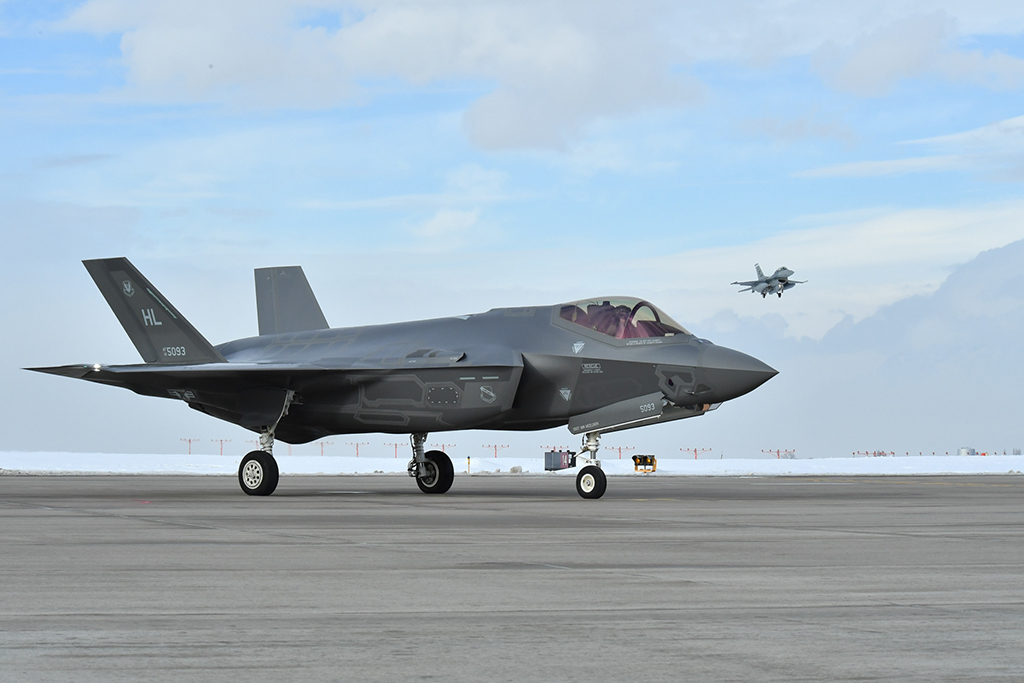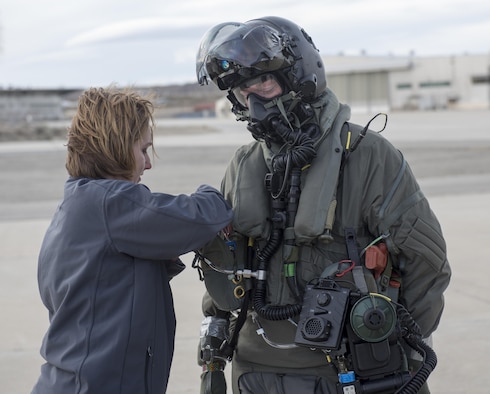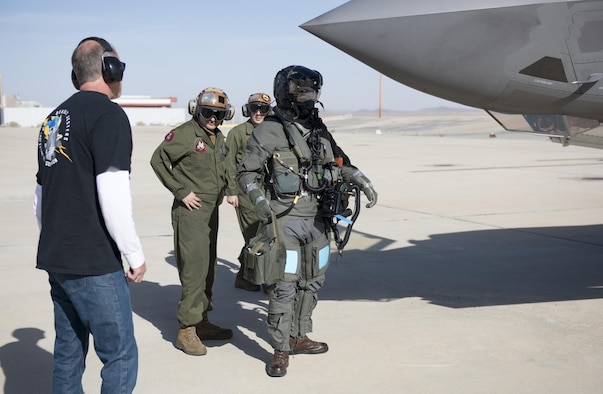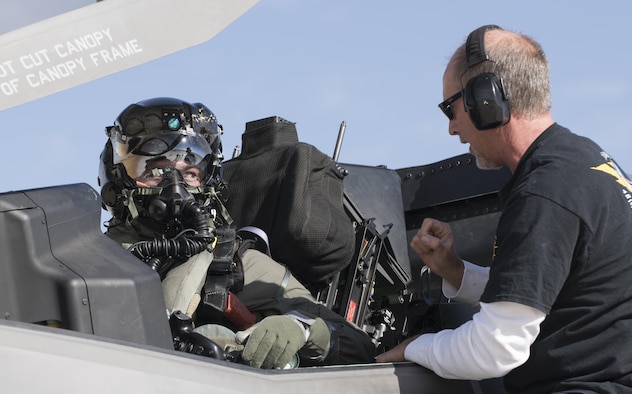JSF pilot ensemble designed to keep out CB agents
By Kenji Thuloweit, 412th Test Wing Public Affairs / Published February 02, 2017
Marine Corps Maj. Douglas Rosenstock, 461st Flight Test Squadron, is inspected by contractor Dr. Angela Theys during a chemical/biological pilot ensemble test Jan. 6. (U.S. Air Force photo by Brad White)
Marine Corps Maj. Aaron Frey (center) prepares to board a Marine F-35B Joint Strike Fighter in a chemical/biological ensemble. All components of the CB ensemble are in addition to the pilot’s sleeved flight jacket and G suit. (U.S. Air Force photo by Brad White)
Marine Corps Maj. Aaron Frey, 461st Flight Test Squadron, speaks with Jim Kristo, 461st FLTS, while seated in an F-35B Jan. 6 during tests of a chemical/biological pilot ensemble. (U.S. Air Force photo by Brad White)
EDWARDS AIR FORCE BASE, Calif. --
After several tests over the past six months to contaminate and decontaminate an F-35 Joint Strike Fighter with simulated chemical and biological agents, the 461st Flight Test Squadron has now moved forward to testing a suit ensemble designed to protect the pilot from those threats.
“Over a decade of planning, flight equipment and decontamination system design and build-up testing have led to this single flight test event,” said Darren Cole, 461st FLTS Human Systems Integration lead.
The chemical/biological ensemble consists of a special CB suit, a Joint Service Aircrew Mask used for the F-35, a pilot-mounted CB air filter, CB socks and gloves double taped at the wrists. The ensemble also features a filtered air blower that protects the pilot from CB contamination while walking to the jet. It provides both breathing air and demist air, which goes to the pilot’s mask and goggles. All components of the CB ensemble are in addition to the pilot’s sleeved flight jacket and G suit.
“Among the data we’re collecting is how much thermal stress is added to the pilot with the CB ensemble on and the impact the additional gear may have on flying the aircraft,” Cole said.
The ensemble also includes a communication device so the pilot can speak to people while wearing the ensemble with helmet and mask.
“It is a conversational communication unit, which is a box that integrates with the communication system so that when he speaks into his mask it lets people hear the pilot talk… it makes him sound like Darth Vader.”
For the CB ensemble tests, an F-35B is on loan from Marine Corps Air Station Yuma, Arizona. Marine Corps test pilots Maj. Aaron Frey and Maj. Douglas Rosenstock from the 461st FLTS donned the CB ensemble for the first tests Jan. 6.
“The first pilot stepped to a clean jet in the CB ensemble and we contaminated it using a simulated agent. The engine run pulls in the simulant so we need to make sure the air is filtered before it gets to the pilot. First, the air goes through the [On-Board Oxygen Generation System] and then the pilot-mounted CB filter to remove any remaining contaminants. There is another filtered air supply blower that provides cooling and demist air to the pilot’s hood and goggles. We also used three air sampling devices to be sure all the air provided to the pilot was clean.”
The simulant sent into the jet’s air intakes is made of elements that have been researched and tested to be safe, but mimic the properties of the harmful agents.
After the ground test, a second pilot came out to simulate stepping to a “dirty jet.” He conducted an engine startup and then took off on a flight. Both pilots wore passive absorption devices on their bodies that the simulated contaminant would stick to if it made it through the CB ensemble. Data was taken from both pilots to see if anything was different from the separate startup scenarios.
“We purposely chose the Marine [short takeoff, vertical landing] version of the F-35 because the equipment is more complicated and basically has more nooks and crannies for the contaminant to hide in. This aircraft also has full-up mission systems. These tests will demonstrate that the U.S. and partner nations can fly, fight, and win in a CB threat environment and then quickly decontaminate the aircraft and return it to normal operation.”
Cole added that this has been the only time this suit has been flown in this configuration on the JSF and is the first ever simulated contaminated aircraft flown for this kind of data collection.
As with all F-35 tests conducted at Edwards, the data will be sent to the F-35 Joint Program Office so procedures can be documented and distributed to F-35 operators in the future so they know what to do while in a chemical or biological threat environment.
“We’ve established the procedures to step to the aircraft and hook into it and the order of powering on systems to get the filtered air supply to the pilot,” said Lauren Gilmore, 461st FLTS, flight test engineer. “We’ve developed procedures on who needs to help the pilot; how many people are needed to support the logistics trail; how many people are needed to help the pilot don the equipment and how many people will be needed in the Life Support unit. We’ve also noted how many Airmen may be needed to escort the pilot out to the aircraft and recover the aircraft. We helped a lot with the F-35 concept of operations.”
The 461st FLTS will have the F-35B from MCAS Yuma through the end of February for the tests.





